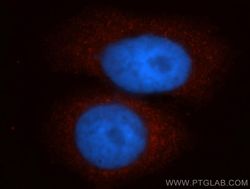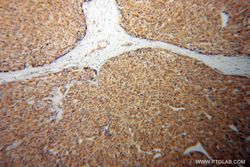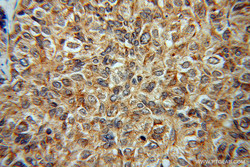Antibody data
- Antibody Data
- Antigen structure
- References [9]
- Comments [0]
- Validations
- Western blot [1]
- Immunocytochemistry [1]
- Immunohistochemistry [2]
Submit
Validation data
Reference
Comment
Report error
- Product number
- 13974-1-AP - Provider product page

- Provider
- Proteintech Group
- Proper citation
- Proteintech Cat#13974-1-AP, RRID:AB_2088078
- Product name
- CTNNA3 antibody
- Antibody type
- Polyclonal
- Description
- KD/KO validated CTNNA3 antibody (Cat. #13974-1-AP) is a rabbit polyclonal antibody that shows reactivity with human, mouse, rat and has been validated for the following applications: IF, IHC, IP, WB,ELISA.
- Reactivity
- Human, Mouse, Rat
- Host
- Rabbit
- Conjugate
- Unconjugated
- Isotype
- IgG
- Vial size
- 20ul, 150ul
Submitted references Exercise training affects calcium ion transport by downregulating the CACNA2D1 protein to reduce hypertension-induced myocardial injury in mice.
Actomyosin-mediated cellular tension promotes Yap nuclear translocation and myocardial proliferation through α5 integrin signaling.
An injury-responsive Rac-to-Rho GTPase switch drives activation of muscle stem cells through rapid cytoskeletal remodeling.
A transcriptome atlas of the mouse iris at single-cell resolution defines cell types and the genomic response to pupil dilation.
Ex Vivo Visualization and Analysis of the Muscle Stem Cell Niche.
α-Catenin-dependent cytoskeletal tension controls Yap activity in the heart.
Alpha-catenins control cardiomyocyte proliferation by regulating Yap activity.
Cell-cell adhesion genes CTNNA2 and CTNNA3 are tumour suppressors frequently mutated in laryngeal carcinomas.
Global landscape of HIV-human protein complexes.
Gao S, Yao W, Zhou R, Pei Z
iScience 2024 Apr 19;27(4):109351
iScience 2024 Apr 19;27(4):109351
Actomyosin-mediated cellular tension promotes Yap nuclear translocation and myocardial proliferation through α5 integrin signaling.
Li X, McLain C, Samuel MS, Olson MF, Radice GL
Development (Cambridge, England) 2023 Jan 15;150(2)
Development (Cambridge, England) 2023 Jan 15;150(2)
An injury-responsive Rac-to-Rho GTPase switch drives activation of muscle stem cells through rapid cytoskeletal remodeling.
Kann AP, Hung M, Wang W, Nguyen J, Gilbert PM, Wu Z, Krauss RS
Cell stem cell 2022 Jun 2;29(6):933-947.e6
Cell stem cell 2022 Jun 2;29(6):933-947.e6
A transcriptome atlas of the mouse iris at single-cell resolution defines cell types and the genomic response to pupil dilation.
Wang J, Rattner A, Nathans J
eLife 2021 Nov 16;10
eLife 2021 Nov 16;10
Ex Vivo Visualization and Analysis of the Muscle Stem Cell Niche.
Goel AJ, Krauss RS
Methods in molecular biology (Clifton, N.J.) 2019;2002:39-50
Methods in molecular biology (Clifton, N.J.) 2019;2002:39-50
α-Catenin-dependent cytoskeletal tension controls Yap activity in the heart.
Vite A, Zhang C, Yi R, Emms S, Radice GL
Development (Cambridge, England) 2018 Mar 8;145(5)
Development (Cambridge, England) 2018 Mar 8;145(5)
Alpha-catenins control cardiomyocyte proliferation by regulating Yap activity.
Li J, Gao E, Vite A, Yi R, Gomez L, Goossens S, van Roy F, Radice GL
Circulation research 2015 Jan 2;116(1):70-9
Circulation research 2015 Jan 2;116(1):70-9
Cell-cell adhesion genes CTNNA2 and CTNNA3 are tumour suppressors frequently mutated in laryngeal carcinomas.
Fanjul-Fernández M, Quesada V, Cabanillas R, Cadiñanos J, Fontanil T, Obaya A, Ramsay AJ, Llorente JL, Astudillo A, Cal S, López-Otín C
Nature communications 2013;4:2531
Nature communications 2013;4:2531
Global landscape of HIV-human protein complexes.
Jäger S, Cimermancic P, Gulbahce N, Johnson JR, McGovern KE, Clarke SC, Shales M, Mercenne G, Pache L, Li K, Hernandez H, Jang GM, Roth SL, Akiva E, Marlett J, Stephens M, D'Orso I, Fernandes J, Fahey M, Mahon C, O'Donoghue AJ, Todorovic A, Morris JH, Maltby DA, Alber T, Cagney G, Bushman FD, Young JA, Chanda SK, Sundquist WI, Kortemme T, Hernandez RD, Craik CS, Burlingame A, Sali A, Frankel AD, Krogan NJ
Nature 2011 Dec 21;481(7381):365-70
Nature 2011 Dec 21;481(7381):365-70
No comments: Submit comment
Supportive validation
- Submitted by
- Proteintech Group (provider)
- Main image

- Experimental details
- mouse testis tissue were subjected to SDS PAGE followed by western blot with 13974-1-AP(CTNNA3 antibody) at dilution of 1:1500
- Sample type
- tissue
Supportive validation
- Submitted by
- Proteintech Group (provider)
- Main image

- Experimental details
- Immunofluorescent analysis of HepG2 cells, using CTNNA3 antibody 13974-1-AP at 1:50 dilution and Rhodamine-labeled goat anti-rabbit IgG (red). Blue pseudocolor = DAPI (fluorescent DNA dye).
- Sample type
- cell line
Supportive validation
- Submitted by
- Proteintech Group (provider)
- Main image

- Experimental details
- Immunohistochemical of paraffin-embedded human liver cancer using 13974-1-AP(CTNNA3 antibody) at dilution of 1:100 (under 10x lens)
- Sample type
- tissue
- Submitted by
- Proteintech Group (provider)
- Main image

- Experimental details
- Immunohistochemical of paraffin-embedded human liver cancer using 13974-1-AP(CTNNA3 antibody) at dilution of 1:100 (under 40x lens)
- Sample type
- tissue
 Explore
Explore Validate
Validate Learn
Learn Western blot
Western blot ELISA
ELISA